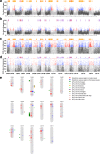Diversification and independent domestication of Asian and European pears
- PMID: 29890997
- PMCID: PMC5996476
- DOI: 10.1186/s13059-018-1452-y
Diversification and independent domestication of Asian and European pears
Abstract
Background: Pear (Pyrus) is a globally grown fruit, with thousands of cultivars in five domesticated species and dozens of wild species. However, little is known about the evolutionary history of these pear species and what has contributed to the distinct phenotypic traits between Asian pears and European pears.
Results: We report the genome resequencing of 113 pear accessions from worldwide collections, representing both cultivated and wild pear species. Based on 18,302,883 identified SNPs, we conduct phylogenetics, population structure, gene flow, and selective sweep analyses. Furthermore, we propose a model for the divergence, dissemination, and independent domestication of Asian and European pears in which pear, after originating in southwest China and then being disseminated throughout central Asia, has eventually spread to western Asia, and then on to Europe. We find evidence for rapid evolution and balancing selection for S-RNase genes that have contributed to the maintenance of self-incompatibility, thus promoting outcrossing and accounting for pear genome diversity across the Eurasian continent. In addition, separate selective sweep signatures between Asian pears and European pears, combined with co-localized QTLs and differentially expressed genes, underline distinct phenotypic fruit traits, including flesh texture, sugar, acidity, aroma, and stone cells.
Conclusions: This study provides further clarification of the evolutionary history of pear along with independent domestication of Asian and European pears. Furthermore, it provides substantive and valuable genomic resources that will significantly advance pear improvement and molecular breeding efforts.
Keywords: Fruit-related traits; Independent domestication; Origin and evolution; Pear (Pyrus); Re-sequencing genomes; Self-incompatibility.
Conflict of interest statement
Competing interests
The authors declare no competing financial interests.
Publisher’s Note
Springer Nature remains neutral with regard to jurisdictional claims in published maps and institutional affiliations.
Figures






Similar articles
-
Contrasting genetic variation and positive selection followed the divergence of NBS-encoding genes in Asian and European pears.BMC Genomics. 2020 Nov 19;21(1):809. doi: 10.1186/s12864-020-07226-1. BMC Genomics. 2020. PMID: 33213380 Free PMC article.
-
An identical-by-descent segment harbors a 12-bp insertion determining fruit softening during domestication and speciation in Pyrus.BMC Biol. 2022 Oct 1;20(1):215. doi: 10.1186/s12915-022-01409-w. BMC Biol. 2022. PMID: 36183077 Free PMC article.
-
Comparative Transcriptomic Analysis Provides Insight into the Domestication and Improvement of Pear (P. pyrifolia) Fruit.Plant Physiol. 2019 May;180(1):435-452. doi: 10.1104/pp.18.01322. Epub 2019 Mar 13. Plant Physiol. 2019. PMID: 30867332 Free PMC article.
-
Finding a Compatible Partner: Self-Incompatibility in European Pear (Pyrus communis); Molecular Control, Genetic Determination, and Impact on Fertilization and Fruit Set.Front Plant Sci. 2019 Apr 16;10:407. doi: 10.3389/fpls.2019.00407. eCollection 2019. Front Plant Sci. 2019. PMID: 31057563 Free PMC article. Review.
-
Genomic insights into citrus domestication and its important agronomic traits.Plant Commun. 2020 Dec 30;2(1):100138. doi: 10.1016/j.xplc.2020.100138. eCollection 2021 Jan 11. Plant Commun. 2020. PMID: 33511347 Free PMC article. Review.
Cited by
-
Changes of Volatile Organic Compounds of Different Flesh Texture Pears during Shelf Life Based on Headspace Solid-Phase Microextraction with Gas Chromatography-Mass Spectrometry.Foods. 2023 Nov 23;12(23):4224. doi: 10.3390/foods12234224. Foods. 2023. PMID: 38231607 Free PMC article.
-
Chromosome-Scale Genome Assembly for Chinese Sour Jujube and Insights Into Its Genome Evolution and Domestication Signature.Front Plant Sci. 2021 Nov 24;12:773090. doi: 10.3389/fpls.2021.773090. eCollection 2021. Front Plant Sci. 2021. PMID: 34899800 Free PMC article.
-
A review of pears (Pyrus spp.), ancient functional food for modern times.BMC Complement Med Ther. 2021 Sep 1;21(1):219. doi: 10.1186/s12906-021-03392-1. BMC Complement Med Ther. 2021. PMID: 34470625 Free PMC article. Review.
-
Population genomic data in spider mites point to a role for local adaptation in shaping range shifts.Evol Appl. 2020 Aug 27;13(10):2821-2835. doi: 10.1111/eva.13086. eCollection 2020 Dec. Evol Appl. 2020. PMID: 33294025 Free PMC article.
-
Integrative physiological and transcriptomic analysis provides insights on the molecular basis of ABA-enhanced drought tolerance in pear (Pyrus betulaefolia).BMC Plant Biol. 2025 Apr 21;25(1):496. doi: 10.1186/s12870-025-06543-5. BMC Plant Biol. 2025. PMID: 40259236 Free PMC article.
References
-
- Potter D, Eriksson T, Evans RC, Oh S, Smedmark JEE, Morgan DR, et al. Phylogeny and classification of Rosaceae. Plant Syst Evol. 2007;266:5–43. doi: 10.1007/s00606-007-0539-9. - DOI
-
- Bell RL, Quamme HA, Layne REC, Skirvin RM. Pears. In: Janick J, Moore JN, editors. Fruit breeding. New York: John Wiley and Sons; 1996. pp. 441–514.
-
- Westwood MN, Bjornstad HO. Some fruit characteristics of interspecific hybrids and extent of self-sterility in Pyrus. Bull Torrey Botanical Club. 1971;98:22–24. doi: 10.2307/2483493. - DOI
-
- Westwood M, Challice J. Morphology and surface topography of pollen and anthers of Pyrus species. J Am Soc Hort Sci. 1978;103:28–37.
-
- Jang JT, Tanabe K, Tamura F, Banno K. Identification of Pyrus species by leaf peroxidase isozyme phenotypes. J Jpn Soc Hortic Sci. 1992;61:273–286. doi: 10.2503/jjshs.61.273. - DOI
Publication types
MeSH terms
Grants and funding
- 31772276/National Natural Science Foundation of China/International
- 31471839/National Natural Science Foundation of China/International
- 31672111/National Natural Science Foundation of China/International
- 31725024/National Natural Science Foundation of China (CN)/International
- CARS-28/Earmarked Fund for China Agriculture Research System/International
LinkOut - more resources
Full Text Sources
Other Literature Sources
Molecular Biology Databases

